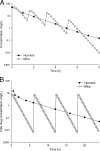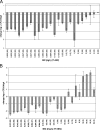Bactericidal activities of meropenem and ertapenem against extended-spectrum-beta-lactamase-producing Escherichia coli and Klebsiella pneumoniae in a neutropenic mouse thigh model
- PMID: 17283197
- PMCID: PMC1855479
- DOI: 10.1128/AAC.00752-06
Bactericidal activities of meropenem and ertapenem against extended-spectrum-beta-lactamase-producing Escherichia coli and Klebsiella pneumoniae in a neutropenic mouse thigh model
Abstract
The purpose of this study was to examine the in vivo efficacies of meropenem and ertapenem against extended-spectrum-beta-lactamase (ESBL)-producing isolates with a wide range of MICs. Human-simulated dosing regimens in mice were designed to approximate the free drug percent time above the MIC (fT>MIC) observed for humans following meropenem at 1 g every 8 h and ertapenem at 1 g every 24 h. An in vivo neutropenic mouse thigh infection model was used to examine the bactericidal effects against 31 clinical ESBL Escherichia coli and Klebsiella pneumoniae isolates and 2 non-ESBL isolates included for comparison at a standard 10(5) inoculum. Three isolates were examined at a high 10(7) inoculum as well. Meropenem displayed greater in vitro potency, with a median MIC (range) (microg/ml) of 0.125 (0.03 to 32), than did ertapenem, with 0.5 (0.012 to 128). Seven of the 31 ESBL isolates were removed from the efficacy analysis due to their inability to establish infection in the mouse model. When MICs were<or=1.5 microg/ml for ertapenem (<or=0.5 microg/ml for meropenem), similar reductions in CFU (approximately 2-log kill) were observed for both ertapenem (fT>MIC>or=23%) and meropenem (fT>MIC>or=75%). Ertapenem showed bacterial regrowth for seven of eight isolates, with MICs of>or=2 microg/ml (fT>MIC<or=20%), while meropenem displayed antibacterial potency that varied from a static effect to a 1-log bacterial reduction in these isolates (fT>MIC=30 to 65%). At a 10(7) inoculum, both agents eradicated bacteria due to adequate exposures (fT>MIC=20 to 45%). Due to low MICs, no difference in bacterial kill was noted for the majority of ESBL isolates tested. However, for isolates with raised ertapenem MICs of>or=2 microg/ml, meropenem displayed sustained efficacy due to its greater in vitro potency and higher resultant fT>MIC.
Figures



Similar articles
-
Pharmacodynamic profiling of imipenem, meropenem and ertapenem against clinical isolates of extended-spectrum beta-lactamase-producing Escherichia coli and Klebsiella spp. from Brazil.Int J Antimicrob Agents. 2006 Oct;28(4):340-4. doi: 10.1016/j.ijantimicag.2006.05.031. Epub 2006 Aug 22. Int J Antimicrob Agents. 2006. PMID: 16930951
-
Pharmacodynamic profile of ertapenem against Klebsiella pneumoniae and Escherichia coli in a murine thigh model.Antimicrob Agents Chemother. 2005 Jan;49(1):276-80. doi: 10.1128/AAC.49.1.276-280.2005. Antimicrob Agents Chemother. 2005. PMID: 15616306 Free PMC article.
-
[Investigation of the susceptibilities of extended-spectrum beta-lactamase-producing Escherichia coli and Klebsiella spp. strains to ertapenem and other carbapenems].Mikrobiyol Bul. 2011 Jan;45(1):28-35. Mikrobiyol Bul. 2011. PMID: 21341156 Turkish.
-
The Role of Cefepime in the Treatment of Extended-Spectrum Beta-Lactamase Infections.J Pharm Pract. 2019 Aug;32(4):458-463. doi: 10.1177/0897190017743134. Epub 2017 Nov 22. J Pharm Pract. 2019. PMID: 29166830 Review.
-
Postoperative meningitis and epidural abscess due to extended-spectrum β-lactamase-producing Klebsiella pneumoniae: a case report and a review of the literature.Intern Med. 2012;51(18):2645-8. doi: 10.2169/internalmedicine.51.8068. Epub 2012 Sep 15. Intern Med. 2012. PMID: 22989843 Review.
Cited by
-
In vivo efficacy of humanized high dose meropenem and comparators against Pseudomonas aeruginosa isolates producing verona integron-encoded metallo-β-lactamase (VIM).Heliyon. 2016 Jun 16;2(6):e00121. doi: 10.1016/j.heliyon.2016.e00121. eCollection 2016 Jun. Heliyon. 2016. PMID: 27441293 Free PMC article.
-
Inoculum effect on the efficacies of amoxicillin-clavulanate, piperacillin-tazobactam, and imipenem against extended-spectrum β-lactamase (ESBL)-producing and non-ESBL-producing Escherichia coli in an experimental murine sepsis model.Antimicrob Agents Chemother. 2013 May;57(5):2109-13. doi: 10.1128/AAC.02190-12. Epub 2013 Feb 25. Antimicrob Agents Chemother. 2013. PMID: 23439636 Free PMC article.
-
In Vivo Activity of WCK 4282 (High-Dose Cefepime/Tazobactam) against Serine-β-Lactamase-Producing Enterobacterales and Pseudomonas aeruginosa in the Neutropenic Murine Lung Infection Model.Antimicrob Agents Chemother. 2021 Mar 18;65(4):e02193-20. doi: 10.1128/AAC.02193-20. Print 2021 Mar 18. Antimicrob Agents Chemother. 2021. PMID: 33431414 Free PMC article.
-
Relationship between Pharmacokinetic/Pharmacodynamic Target Attainment and Microbiological Outcome in Critically Ill COVID-19 Patients with Documented Gram-Negative Superinfections Treated with TDM-Guided Continuous-Infusion Meropenem.Pharmaceutics. 2022 Jul 29;14(8):1585. doi: 10.3390/pharmaceutics14081585. Pharmaceutics. 2022. PMID: 36015211 Free PMC article.
-
Development and confirmation of humanized plasma and epithelial lining fluid exposures of meropenem, cefiderocol and tobramycin in a standardized neutropenic murine pneumonia model.J Antimicrob Chemother. 2025 Feb 3;80(2):478-484. doi: 10.1093/jac/dkae432. J Antimicrob Chemother. 2025. PMID: 39657022 Free PMC article.
References
-
- Andes, D., and W. A. Craig. 2001. Impact of extended-spectrum beta-lactamase production on the activity of cefepime in a murine-thigh infection model, abstr. 1099. Abstr. 41st Intersci. Conf. Antimicrob. Agents Chemother. American Society for Microbiology, Washington, DC.
-
- Clinical and Laboratory Standards Institute. 2006. Methods for dilution antimicrobial susceptibility tests for bacteria that grow aerobically. Approved standard, 7th ed. CLSI document M7-A7. Clinical and Laboratory Standards Institute, Wayne, PA.
-
- Craig, W. A. 1998. Pharmacokinetic/pharmacodynamic parameters: rationale for antibacterial dosing of mice and men. Clin. Infect. Dis. 26:1-10. - PubMed
-
- Craig, W. A., S. M. Bhavnani, and P. G. Ambrose. 2004. The inoculum effect: fact or artifact? Diagn. Microbiol. Infect. Dis. 50:229-230. - PubMed
Publication types
MeSH terms
Substances
LinkOut - more resources
Full Text Sources
Other Literature Sources

